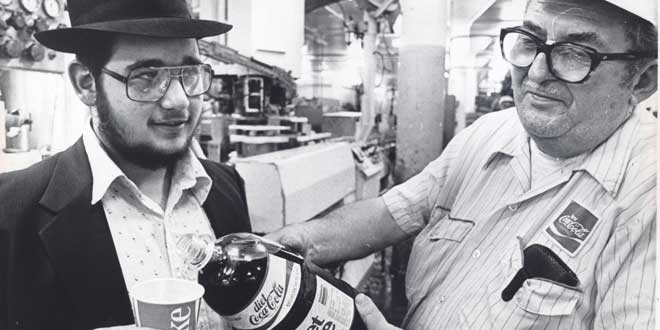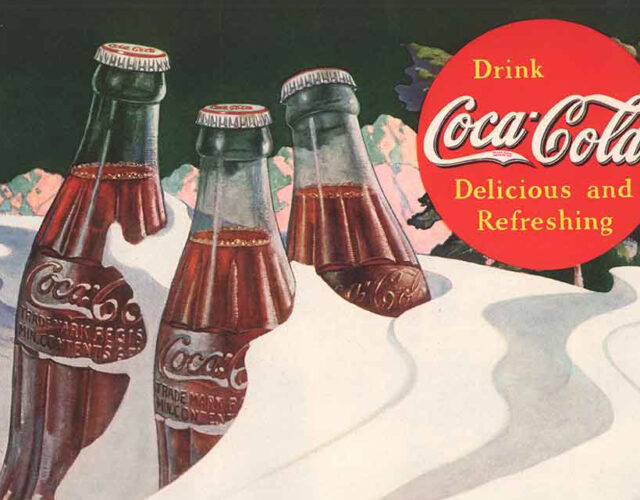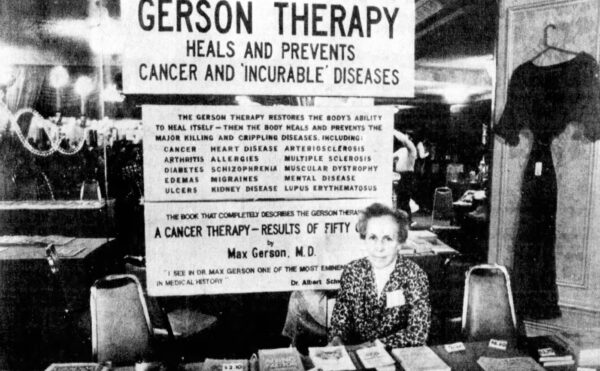In the early 1930s Tobias Geffen, an Orthodox rabbi, began to receive a steady stream of letters from rabbis across the United States asking whether Coca-Cola was kosher. Coke was a popular beverage among Jews, and rabbis were worried. Since Coca-Cola was headquartered in Atlanta, where Geffen lived, he was essentially deputized by other rabbis to investigate. Rabbi Geffen did indeed discover a problem, a nonkosher ingredient present in Coke as well as in many other foods and beverages.
Today, about 40% to 50% of the items in a conventional U.S. supermarket are certified kosher by Orthodox rabbis. Yet there are at most one million observant Jews in a country of over 300 million people. With these numbers how did kosher products become so prevalent, and why do so many American businesses make food to accommodate kosher requirements? The story of how Coke became kosher helps unravel this paradox.
Rule of Law
The rules about kosher food go back to antiquity. Early oral traditions were codified in the Babylonian Talmud in the sixth century CE and then drawn together succinctly in the 16th-century Shulchan Aruch of Rabbi Joseph Karo. In and around these major documents generations upon generations of rabbis have woven a complex, sophisticated body of law governing food consumption by Jews. Separation between acceptable and unacceptable foods provides the core concept. Certain kinds of livestock, such as pigs, can never be kosher, while permissible types of animals, like cattle and chickens, must be slaughtered properly and inspected to determine whether they meet demanding kosher requirements. Kosher meat must also remain separate from foods classified in kosher law as “milk,” which includes cheese. In addition to the categories of milk and meat, kosher law provides for a third category, called parve, or neutral, that can be eaten with both of the other categories.
Some of these classifications might seem odd and arbitrary: fish and eggs, for example, are parve, even though both come from living creatures. Then, while insects are never kosher, honey, which is the product of an insect, is both kosher and parve; yet for milk to be kosher, it must come from an animal that is acceptable for observant Jews to eat. Behind these seemingly arbitrary classifications lie over a thousand years of debate among rabbis across Europe and the Middle East.
This sophisticated kosher law, developed over two millennia, has been profoundly challenged in the last 100 years by our modern food system. Processed food disrupted the stable categories on which kosher law was based through the inclusion of ingredients intended to make these products taste better, look attractive, and last longer. Manufacturers never identified the source of these ingredients, and many were included in such small quantities that they were not even listed on labels. How then to determine whether these new processed foods were kosher?
The rigid categories prescribed by kosher law were no longer self-evident in modern food, and rabbis schooled in pre-industrial Jewish law needed to figure out how to extend those principles to 20th-century conditions. They needed not only to apply kosher law to contemporary food manufacturing but also to ask American food manufacturers to accommodate kosher rules in the manufacturing process.
Out of these efforts came a new body of thought and practice that can be termed “kosher chemistry.” The sophisticated application of chemistry has made many contemporary foods that once were off limits acceptable to observant Jews. Much of the thanks goes to kosher chemists trained in theology and science, who successfully merged what might seem to be utterly opposed systems of thought.
Hard to Swallow
Jews widely drank Coke, and Coca-Cola actively sought Jewish consumers. But was the drink kosher? Answering that seemingly straightforward question led to Coca-Cola becoming the first nationally prominent company to adapt its product contents for kosher requirements. Creating a kosher Coke established important precedents for the future expansion of kosher-certified products.

Rabbi Geffen was the principal figure in the development of kosher Coke. As a leading figure in Atlanta’s Jewish community since his arrival in 1910 as chief rabbi of Shearith Israel, Geffen was well-positioned to secure Coca-Cola’s cooperation in this investigation. He even persuaded the company to reveal to him, in strictest confidence, the drink’s famed secret ingredient.
His investigation into Coke’s contents determined that a seemingly innocuous chemical known as glycerin was unacceptable under kosher law. This slightly sweet, syrupy liquid was and is widely used to diffuse flavor—such as Coke’s secret ingredient—in beverages, keep cakes moist and fresh, prevent ice crystals from forming in ice cream, and ensure that breads are not too crumbly. Why was this miracle of modern science a problem? Geffen learned that glycerin was a by-product of soap manufacturing, which used fatty oils generated from meat processing, including from pigs and cattle that were not kosher slaughtered. Yet glycerin itself did not exist in nature, independent of such manufacturing; moreover, glycerin created from vegetable-based fatty oils was chemically identical to glycerin derived from pork fat.
In a ruling that had immense implications Geffen held that the kosher status of glycerin was dependent on its source. In other words, if glycerin originated from a nonkosher animal, it wasn’t kosher; if it came from vegetable sources, it could be kosher. Geffen’s ruling would become the standard that Orthodox rabbis used to evaluate the kosher status of all questionable ingredients in food, such as spices, food colors, and preservatives.
Geffen also had to address the implications of the infinitesimal amount of glycerin in Coke—less than 0.01% of its volume. Did such a small amount fall under the well-established kosher principle of bitul (nullification), meant to accommodate mistakes made while cooking, such as inadvertently dropping a pat of butter into beef stew. If the butter amounted to less than one-sixtieth of the volume of the stew, then the butter was bitul b’shishim (nullified in the sixtieth), and the stew was still kosher, even though it contained a small amount of milk.
Since glycerin composed far less than one-sixtieth of the volume of Coke, Geffen had to consider whether it was bitul b’shishim—nullified—rendering Coke kosher. He held that it wasn’t nullified since the traditional concept of bitul only applied to accidents, while the use of glycerin in Coke was deliberate. As a result Geffen determined that conventional Coke was not permissible for observant Jewsto drink.
Geffen’s ruling had far broader implications; his extension of traditional kosher law to modern food meant that every ingredient, no matter how minute, now had to be kosher. If Geffen had ruled differently, he might have opened the door to “kosher” food containing prohibited chemicals.
Coke’s response to Geffen also set a very important precedent. While its chemists and executives may have had a hard time understanding Geffen’s insistence on differentiating between glycerin made from animal fats and glycerin made from vegetable oils, they nonetheless accepted his ruling. And since they did indeed want to eliminate any obstacles to reaching new markets, including observant Jews, the company went about finding a way to accommodate Geffen’s objections.
The company asked Procter and Gamble, its glycerin supplier, if they could deliver glycerin derived from vegetable fats. Procter and Gamble, for its part, had been making Crisco shortening from cottonseed oil for over 20 years and was well aware of its use by observant Jewish consumers. Consequently, the company fully understood Coca-Cola’s request and agreed to supply glycerin made from cottonseed oil. To document its compliance with kosher requirements, Coke collected affidavits certifying that the glycerin used in special batches of Coke syrup came from cottonseed oil. With this evidence in hand Geffen issued a teshuva (ruling) in 1935 that the reformulated Coke did indeed meet Jewish dietary requirements. Observant Jews could at last relax with their bottle of Coca-Cola in hand.
Or so they thought . . . .
Separation Anxiety
Controversy erupted again in the 1950s when rabbis discovered that the vegetable-derived glycerin used to make kosher Coke traveled through the same piping system used by nonkosher glycerin in Procter and Gamble plants. Their concerns stemmed from an important kosher principle known as blios—literally, taste—that applies to the materials touched by food and food ingredients.
Blios generally refers to the residue—however minute—left by food on the surfaces it touches and how that “taste” could transfer to later batches of food that touch the same surface. The commonplace practice among observant Jews to maintain separate dishes, pots, and utensils at home for milk and meat meals stems from a concern about blios. The rabbis who were uneasy with Procter and Gamble’s glycerin-production methods applied the same principle to the containers, surfaces, pipes, and any other places that allowed for the transfer of nonkosher glycerin residues to kosher glycerin. By that standard the glycerin used in Coke was not kosher, even though it came from vegetable oils, because it had been contaminated by the glycerin derived from nonkosher animal fats.
Doubtless this subtlety in kosher law escaped the Procter and Gamble and Coca-Cola executives who were sincerely trying to observe kosher requirements. Indeed, the affidavits obtained by Rabbi Geffen were truthful since the glycerin had been made from cottonseed oil. Procter and Gamble probably never worried about the details: from a conventional manufacturing perspective the animal fats–derived glycerin in the pipes was the same chemical as that produced from cottonseed oil, and so there were no ill consequences. The companies, even if mystified by the concept of blios, nonetheless went along with the rabbis’ requirements. Procter and Gamble defused the controversy by spending $30,000 to construct a parallel piping system to separate the glycerin that was kosher from the glycerin that was not.
This final episode brought to a close Coke’s importance as a precedent in the creation of kosher food: it unmistakably established that all equipment coming into contact with kosher food must remain uncontaminated by nonkosher materials. Just as Geffen’s stand on ingredients imposed stringent requirements for what could be included in kosher processed food, so too did the rigorous application of blios establish a high standard for how firms would control and regulate the production of kosher-certified food.

Seal of Approval
The creation of kosher Coke—along with other efforts to make processed foods kosher—had an even more profound effect: Orthodox rabbis realized that they needed to learn chemistry if they were to effectively supervise the production of modern kosher food. Understanding 2,000 years of kosher law was not enough. By the late 1950s knowledge of chemistry and of food manufacturing was integral to the process of certifying kosher food.
This knowledge has since become incorporated into the certification of kosher food in various ways. It is now possible to speak not only about kosher chemistry but also about a new generation of kosher chemists. In many cases rabbis have learned chemistry specific to the areas of food that they certify, such as oils or wine. Certification organizations often employ chemists and food scientists as consultants to advise them on the certification process. In a few cases rabbis have themselves obtained advanced scientific degrees. The president of Star-K Kosher Certification, Avrom Pollack, has a rabbinic ordination and a doctorate in cell and molecular biology.
These chemists deserve much of the credit for the remarkable growth in kosher food products. Of course, clever food marketers have played a role, too. The famous tagline “You don’t have to be Jewish to love Levy’s” along with Hebrew National’s brilliant phrase “We answer to a higher authority” have doubtless expanded kosher food’s appeal. But both advertising campaigns rest on a claim that kosher food is more reliable, safer, and more consistent in its contents than nonkosher food because rabbis’ devotion to their faith places their judgment above suspicion. And these claims in turn depend on the hard work done by Rabbi Geffen and the ranks of kosher chemists who have been scrupulous in their application of kosher law to modern food.
The result has been widespread interest by nonkosher consumers in kosher food. In the late 1980s the prestigious market-research firm Packaged Facts issued an influential report showing that only one in four purchasers of kosher products were in fact Jewish. Twenty years later a similar report would show that only one in ten kosher food purchasers were observant Jews. Today this fact is widely accepted among food manufacturers, who also maintain the corresponding belief that kosher certification can in many cases bolster their product’s image and increase sales, not only to observant Jews but also to many other consumers concerned about what they eat.
The diligence of kosher chemists has made it possible for kosher food to have such a broad appeal. Insistence on stringent standards for ingredients and processing means that Muslims can trust that kosher-certified food will not contain any ingredients originating from a pig. Vegetarians can be confident that kosher food labeled as dairy will contain no meat products. Conversely, lactose-intolerant or allergic consumers know that foods labeled meat or parve will not trigger milk-based health problems.
Ironically, kosher food’s appeal to nonkosher consumers was an entirely unanticipated outgrowth of kosher chemistry. When Orthodox rabbis developed the rigorous rules governing the production of Coke and other processed food products, they were not thinking about the non-Jewish consumer. They were concerned exclusively with being true to the principles of Jewish law. But this unintended consequence has made the growth of kosher-certified products a mitzvah, a good deed, from which many have benefited, not only observant Jews.
This article is drawn from Roger Horowitz’s book on the history of kosher food in the United States.




